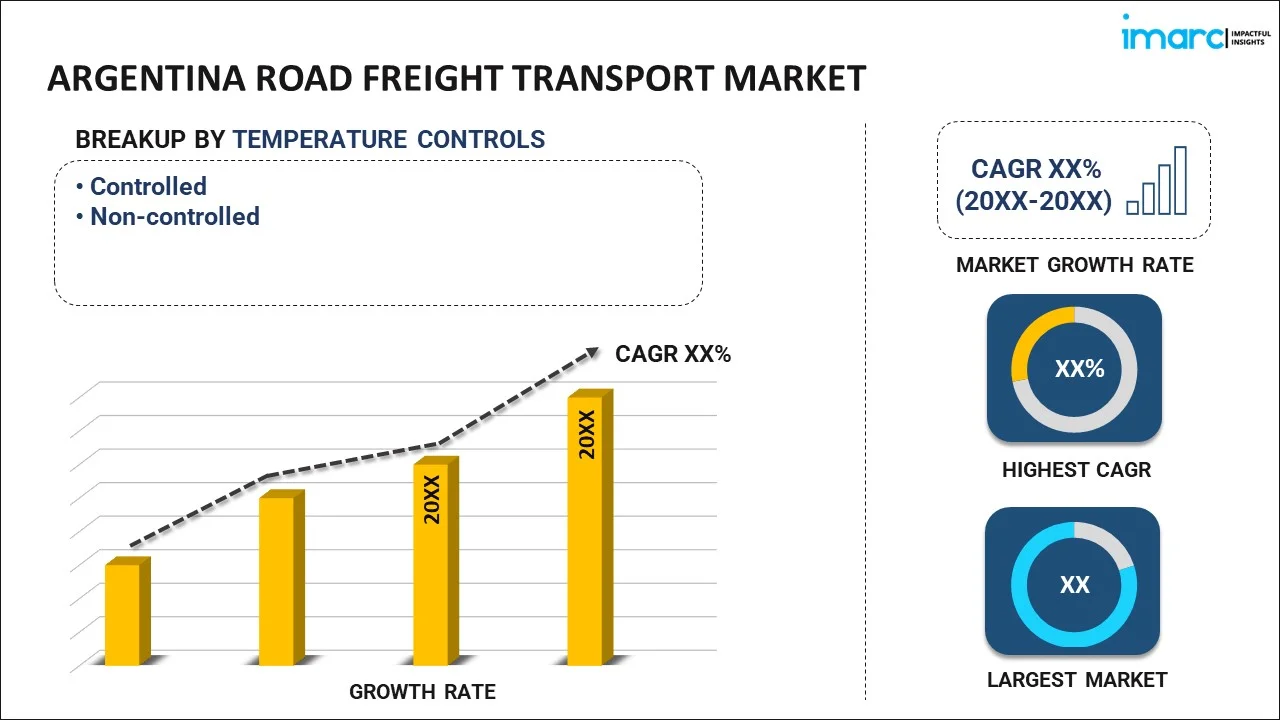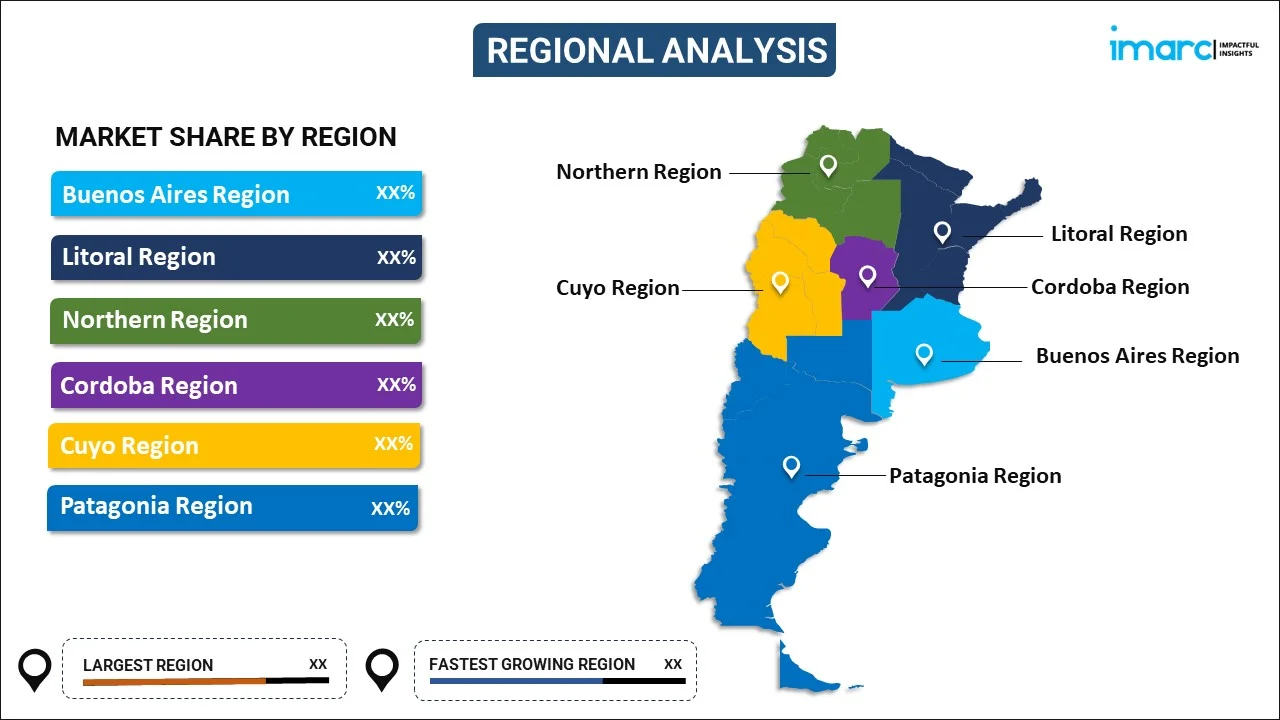
Argentina Road Freight Transport Market Report by Temperature Control (Controlled, Non-controlled), Product Type (Liquid Goods, Solid Goods), Distance (Long Haul, Short Haul), Containerization (Containerized, Non-containerized), Destination (Domestic, International), End User (Agriculture, Fishing and Forestry, Construction, Manufacturing, Oil and Gas, Mining and Quarrying, Wholesale and Retail Trade, and Others), and Region 2024-2032
Argentina Road Freight Transport Market Overview:
The Argentina road freight transport market is projected to exhibit a growth rate (CAGR) of 6.20% during 2024-2032. The increasing industrial production, growth in e-commerce, infrastructure improvements, the rising demand for efficient and reliable delivery services, and government initiatives to enhance transportation networks are some of the major factors propelling the growth of the market across Argentina.
|
Report Attribute
|
Key Statistics
|
|---|---|
|
Base Year
|
2023 |
|
Forecast Years
|
2024-2032
|
|
Historical Years
|
2018-2023
|
| Market Growth Rate (2024-2032) | 6.20% |
Argentina Road Freight Transport Market Trends:
Growth in E-commerce
The rapid expansion of e-commerce is leading to a rise in the demand for efficient and timely delivery services, significantly driving the road freight market. According to the International Trade Administration, E-commerce activity has grown tenfold since 2000 in peso terms. Argentina has over 37 million internet users, the third highest percentage in Latin America after Brazil and Mexico. According to the Argentine Chamber of Information and Communications (CICOMRA), in 2022 Argentina had 26 million urban households with access to computers and 82 percent connected to the internet. Nine out of 10 people use a cell phone, and nine out of 10 use the internet. Network expansion is increasing the availability of WiFi connections in public and privately owned spaces. The Argentine Chamber of Electronic Commerce (CACE) reports that 95 percent of connected Argentine adults (19 million people) have made online purchases at least once. E-commerce in Argentina experienced rapid growth of 87 percent in 2022. Seventy-eight percent of total sales were made by credit card.
Increased Industrial Production
As industrial activities grow, there is a higher demand for the transportation of raw materials and finished goods, thereby facilitating the need for road freight services. According to Trading Economics, industrial production in Argentina plunged by 16.6% year-on-year in April 2024, marking the eleventh consecutive month of contraction but showing a notable improvement from the substantial decline of 21.2% in the previous month, the steepest since May 2020. The improvement was observed across several sectors, including basic metals (-25.7% vs -34.8% in March), other equipment, devices, and instruments (-35.5% vs -42.8%), the manufacturing industry (-35% vs -40.4%), wood, paper, publishing, and printing (-13.7% vs -19.3%), machinery and equipment (-25.1% vs -32.6%), and food and beverages output (-9.3% vs -14.4%), all of which declined at a slower rate.
Argentina Road Freight Transport Market News:
- In September 2023, DHL announced the launch of its first dedicated network flight to Argentina, which will operate 6 times per week between Miami International Airport and Buenos Aires, Argentina. Operated by DHL Aero Expreso, the Boeing B767-300 aircraft will provide a gross payload capacity of 47 tonnes per flight and include a stopover in Santiago.
- In March 2024, The Argentine government announced that it plans to allocate approximately USD 550 million towards the construction of a new port in the Rosario region, a vital agricultural centre responsible for over 80% of the nation’s agricultural and agro-industrial exports. The facility is planned to be built some 50 km north of the city of Rosario, Reuters reported.
Argentina Road Freight Transport Market Segmentation:
IMARC Group provides an analysis of the key trends in each segment of the market, along with forecasts at the country level for 2024-2032. Our report has categorized the market based on temperature control, product type, distance, containerization, destination, and end user.
Temperature Control Insights:

- Controlled
- Non-controlled
The report has provided a detailed breakup and analysis of the market based on the temperature control. This includes controlled and non-controlled.
Product Type Insights:
- Liquid Goods
- Solid Goods
A detailed breakup and analysis of the market based on the product type have also been provided in the report. This includes liquid goods and solid goods.
Distance Insights:
- Long Haul
- Short Haul
The report has provided a detailed breakup and analysis of the market based on the distance. This includes long haul and short haul.
Containerization Insights:
- Containerized
- Non-containerized
A detailed breakup and analysis of the market based on the containerization have also been provided in the report. This includes containerized and non-containerized.
Destination Insights:
- Domestic
- International
The report has provided a detailed breakup and analysis of the market based on the destination. This includes domestic and international.
End User Insights:
- Agriculture, Fishing and Forestry
- Construction
- Manufacturing
- Oil and Gas, Mining and Quarrying
- Wholesale and Retail Trade
- Others
A detailed breakup and analysis of the market based on the end user have also been provided in the report. This includes agriculture, fishing and forestry, construction, manufacturing, oil and gas, mining and quarrying, wholesale and retail trade, and others.
Regional Insights:

- Buenos Aires Region
- Litoral Region
- Northern Region
- Cordoba Region
- Cuyo Region
- Patagonia Region
The report has also provided a comprehensive analysis of all the major regional markets, which include Buenos Aires Region, Litoral Region, Northern Region, Cordoba Region, Cuyo Region, and Patagonia Region.
Competitive Landscape:
The market research report has also provided a comprehensive analysis of the competitive landscape in the market. Competitive analysis such as market structure, key player positioning, top winning strategies, competitive dashboard, and company evaluation quadrant has been covered in the report. Also, detailed profiles of all major companies have been provided.
Argentina Road Freight Transport Market Report Coverage:
| Report Features | Details |
|---|---|
| Base Year of the Analysis | 2023 |
| Historical Period | 2018-2023 |
| Forecast Period | 2024-2032 |
| Units | Billion US$ |
| Scope of the Report | Exploration of Historical and Forecast Trends, Industry Catalysts and Challenges, Segment-Wise Historical and Predictive Market Assessment:
|
| Temperature Controls Covered | Controlled, Non-controlled |
| Product Types Covered | Liquid Goods, Solid Goods |
| Distances Covered | Long Haul, Short Haul |
| Containerizations Covered | Containerized, Non-containerized |
| Destinations Covered | Domestic, International |
| End Users Covered | Agriculture, Fishing and Forestry, Construction, Manufacturing, Oil and Gas, Mining and Quarrying, Wholesale and Retail Trade, Others |
| Regions Covered | Buenos Aires Region, Litoral Region, Northern Region, Cordoba Region, Cuyo Region, Patagonia Region |
| Customization Scope | 10% Free Customization |
| Post-Sale Analyst Support | 10-12 Weeks |
| Delivery Format | PDF and Excel through Email (We can also provide the editable version of the report in PPT/Word format on special request) |
Key Questions Answered in This Report:
- How has the Argentina road freight transport market performed so far and how will it perform in the coming years?
- What has been the impact of COVID-19 on the Argentina road freight transport market?
- What is the breakup of the Argentina road freight transport market on the basis of temperature control?
- What is the breakup of the Argentina road freight transport market on the basis of product type?
- What is the breakup of the Argentina road freight transport market on the basis of distance?
- What is the breakup of the Argentina road freight transport market on the basis of containerization?
- What is the breakup of the Argentina road freight transport market on the basis of destination?
- What is the breakup of the Argentina road freight transport market on the basis of end user?
- What are the various stages in the value chain of the Argentina road freight transport market?
- What are the key driving factors and challenges in the Argentina road freight transport?
- What is the structure of the Argentina road freight transport market and who are the key players?
- What is the degree of competition in the Argentina road freight transport market?
Key Benefits for Stakeholders:
- IMARC’s industry report offers a comprehensive quantitative analysis of various market segments, historical and current market trends, market forecasts, and dynamics of the Argentina road freight transport market from 2018-2032.
- The research report provides the latest information on the market drivers, challenges, and opportunities in the Argentina road freight transport market.
- Porter's five forces analysis assist stakeholders in assessing the impact of new entrants, competitive rivalry, supplier power, buyer power, and the threat of substitution. It helps stakeholders to analyze the level of competition within the Argentina road freight transport industry and its attractiveness.
- Competitive landscape allows stakeholders to understand their competitive environment and provides an insight into the current positions of key players in the market.
Need more help?
- Speak to our experienced analysts for insights on the current market scenarios.
- Include additional segments and countries to customize the report as per your requirement.
- Gain an unparalleled competitive advantage in your domain by understanding how to utilize the report and positively impacting your operations and revenue.
- For further assistance, please connect with our analysts.
 Inquire Before Buying
Inquire Before Buying
 Speak to an Analyst
Speak to an Analyst
 Request Brochure
Request Brochure
 Request Customization
Request Customization




.webp)




.webp)












